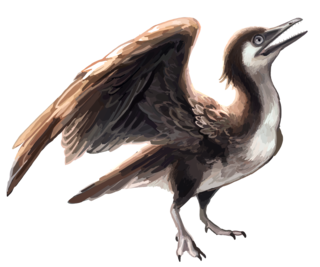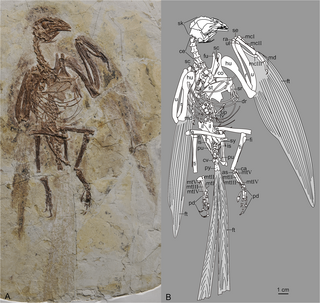
The Enantiornithes, also known as enantiornithines or enantiornitheans in literature, are a group of extinct avialans, the most abundant and diverse group known from the Mesozoic era. Almost all retained teeth and clawed fingers on each wing, but otherwise looked much like modern birds externally. Over eighty species of Enantiornithes have been named, but some names represent only single bones, so it is likely that not all are valid. The Enantiornithes became extinct at the Cretaceous–Paleogene boundary, along with Hesperornithes and all other non-avian dinosaurs.

Longipteryx is a genus of prehistoric bird which lived during the Early Cretaceous. It contains a single species, Longipteryx chaoyangensis. Its remains have been recovered from the Jiufotang Formation at Chaoyang in Liaoning Province, China. Apart from the holotype IVPP V 12325 - a fine and nearly complete skeleton — another entire skeleton and some isolated bones are known to date.

Sapeornis is a monotypic genus of avialan dinosaurs which lived during the early Cretaceous period. Sapeornis contains only one species, Sapeornis chaoyangensis.

Hongshanornis is a genus of ornithuromorph birds known from early Cretaceous lake deposits of the Yixian Formation, Inner Mongolia, China. The holotype specimen, recovered in 2005, is currently held by the Institute of Vertebrate Paleontology and Paleoanthropology in Beijing. It was found in the Jianshangou fossil beds, dated to 124.6 million years ago. Three additional specimens have been reported, though only one of those has been definitively identified as belonging to Hongshanornis. This latter specimen was found in the Dawangzhangzi fossil beds, which are about 122 million years old.

Yixianornis is a bird genus from the early Cretaceous period. Its remains have been found in the Jiufotang Formation at Chaoyang dated to the early Aptian age, around 120 million years ago. Only one species, Yixianornis grabaui, is known at present. The specific name, grabaui, is named after American paleontologist Amadeus William Grabau, who surveyed China in the early 20th century.

Archaeorhynchus is a genus of beaked avialan stem-birds from the early Cretaceous period. A fossil of its only known species, Archaeorhynchus spathula, was first reported in 2005 by Zhou & Zhang to have been found in Yixian Formation rocks at Yixian, Liaoning province, China, showing a well-preserved and essentially complete skeleton. Two more complete specimens were found in Lower Cretaceous deposits of Jianchang, Liaoning, northeastern China, preserving new anatomical information. These deposits are 120 million years old, whereas the original specimen was 125 million years old, meaning the age range for this species is 125-120Ma.
Songlingornis is an extinct genus of ornithuromorph dinosaurs from the Early Cretaceous. Its fossils have been found in the Jiufotang Formation of Liaoning (PRC). The age of these rocks is somewhat disputed, but probably around the early Aptian, 125-120 million years ago. Only one species, Songlingornis linghensis, is known at present.
The Jiufotang Formation is an Early Cretaceous geological formation in Chaoyang, Liaoning which has yielded fossils of feathered dinosaurs, primitive birds, pterosaurs, and other organisms. It is a member of the Jehol group. The exact age of the Jiufotang has been debated for years, with estimates ranging from the Late Jurassic to the Early Cretaceous. New uranium-lead dates reveal the formation is deposited in the Aptian stage of the Early Cretaceous. Fossils of Microraptor and Jeholornis are from the Jiufotang.

Protopteryx is an extinct bird and possibly the basalmost enantiornithean, from the Cretaceous period. The type species is P. fengningensis. It was first discovered in the Sichakou Member of the Yixian Formation or Huajiying Formation of Hebei Province, northern China, dating from 131 Ma ago. Protopteryx has been found in the Daibeigou formation, as well. The name Protopteryx means "primitive feather": "proto-" meaning "the first of" and "-pteryx" meaning "feather" or "wing." The name comes from the fact that Protopteryx feathers are more primitive than those of modern birds, such as the two elongated tail feathers that lack barbs and rami.
Pengornis is the largest known enantiornithine bird from the Early Cretaceous of northeast China. The name derives from "Peng", which refers to a mythological bird from Chinese folklore, and "-ornis", which means bird in Greek.

Shanweiniao is a genus of long-snouted enantiornithean birds from Early Cretaceous China. One species is known, Shanweiniao cooperorum. There is one known fossil, a slab and counterslab. The fossil is in the collection of the Dalian Natural History Museum, and has accession number DNHM D1878/1 and DNHM1878/2. It was collected from the Lower Cretaceous Dawangzhengzi Beds, middle Yixian Formation, from Lingyuan in the Liaoning Province, China.

Songlingornithidae is a family of basal euornithean dinosaurs from the Early Cretaceous of China. All known specimens come from the Jiufotang Formation and the Yixian Formation, dating to the early Barremian and Aptian ages, 125–120 million years ago.

Yanornithiformes is an order of ornithuromorph dinosaurs from the early Cretaceous Period of China. All known specimens come from the Yixian Formation and Jiufotang Formation, dating to the early Aptian age, 124.6 to 120 million years ago.

Longipterygidae is a family of early enantiornithean avialans from the Early Cretaceous epoch of China. All known specimens come from the Jiufotang Formation and Yixian Formation, dating to the early Aptian age, 125-120 million years ago.

Bohaiornis is a genus of enantiornithean birds. Fossils have been found from the Lower Cretaceous Jiufotang Formation of western Liaoning, China. The only known species, Bohaiornis guoi, was named by Dongyu Hu, Li Li, Lianhaim Hou and Xing Xu in 2011 on the basis of a fully articulated and well-preserved skeleton of a sub-adult. This specimen, LPM B00167, preserved two long, ribbon-like feathers attached to the tail rather than a fan of shorter pennaceous feathers. It was similar to the slightly older Eoenantiornis, but much larger in size. Bohaiornis is the type species of Bohaiornithidae, a family of large predatory enantiornitheans from the Early Cretaceous.

Euornithes is a natural group which includes the most recent common ancestor of all avialans closer to modern birds than to Sinornis.
Ambiortiformes is a group of prehistoric ornithuromorph dinosaurs.

Bohaiornithidae is a group of early predatory enantiornitheans from the early Cretaceous Period of China. All known specimens come from the Jiufotang Formation and Yixian Formation, dating to the early Aptian age, 125–120 million years ago. Bohaiornithidae was first coined as a family of enantiornithean birds by Wang and colleagues in 2014. They defined it as the natural group formed by all descendants of the common ancestor of the type species, Bohaiornis guoi, and Shenqiornis mengi.

Parapengornis is an extinct genus of enantiornithine bird from the Lower Cretaceous of what is now China. The holotype specimen was discovered in the Jiufotang Formation near Lingyuan, western Liaoning province, and was catalogued as IVPP V18687. The nearly complete, articulated specimen is preserved on a slab and has impressions of pennaceous feathers. Only parts of the sternum, the left hand, and right foot are missing. In 2015, it became the basis of the new genus and species Parapengornis eurycaudatus, named by the Chinese palaeontologists Han Hu, Jingmai K. O’Connor, and Zhonghe Zhou. The generic name consists of the Latin word para and the name of the related genus Pengornis, indicating their close relationship. The name Pengornis is itself derived from "Peng", a mythological bird from Chinese folklore, and ornis, which means bird in Greek. The specific name is derived from the Latin words eury, meaning broad, and caudatus, meaning tail, in reference to the broad and expanded pygostyle. A nearly complete specimen formerly assigned to Pengornis was also reassigned to Parapengornis by these authors.


























